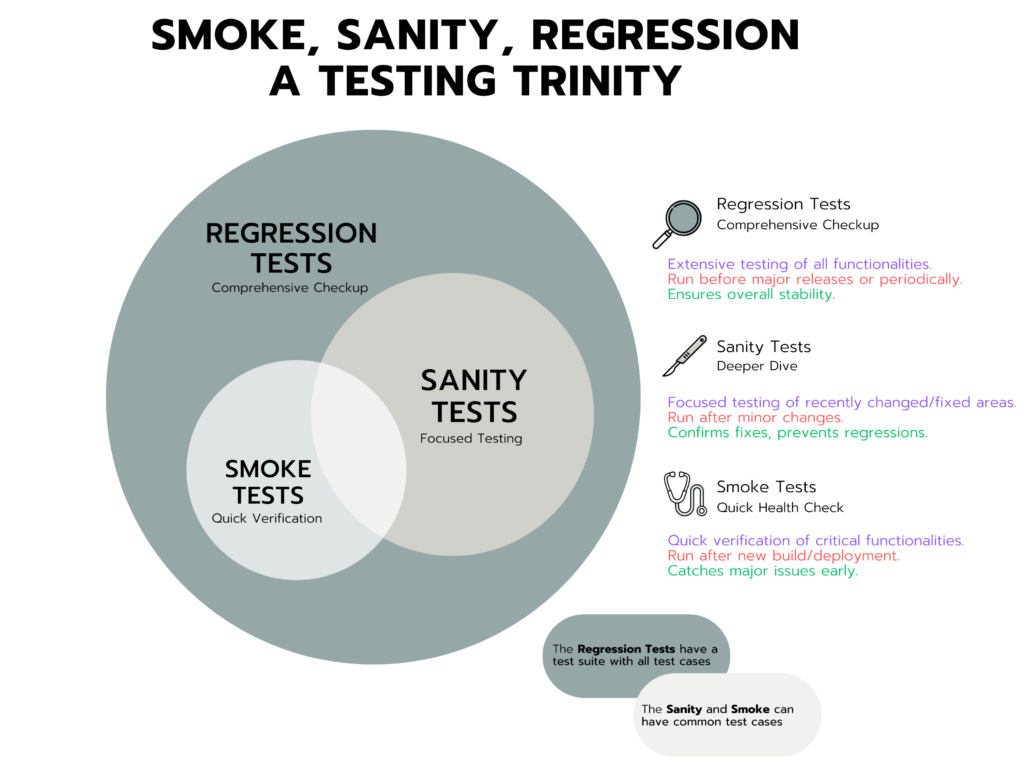Ensuring Accessibility: A Crucial Element in Web Development
- March 20
- 5 min

In the constantly changing landscape of software development, ensuring the quality and reliability of your code is essential. Here is where testing comes into play, serving as a safety net that catches bugs and glitches before they reach your users. However, not all tests are created equal. This post will clarify the confusion around three frequently mixed-up tests: smoke, sanity, and regression. We’ll dive into their unique roles and discover how to use them effectively.
Even though they’re important, smoke, sanity, and regression tests are often mixed up or misunderstood, leading to their incorrect use and missed issues. The lines between these tests can blur, particularly when dealing with smaller, less complex applications. This confusion can result in wasted resources, insufficient testing coverage, and ultimately, the risk of releasing software with undetected bugs or regressions. Understanding the nuances of each test type is crucial for establishing a solid and effective testing strategy.
The name of this test type refers to checking if a device literally “smokes” (fails) when first turned on. Imagine a smoke test as a glance at your application’s key functions. It’s a set of high-level tests designed to quickly verify that the most critical functionalities are working as expected. Think of it as a doctor checking your pulse and blood pressure. A smoke test is typically performed after a new build or deployment, acting as a gatekeeper that prevents faulty code from progressing further in the development pipeline.
If smoke tests are a quick pulse check, sanity checks are a more detailed examination. They are a subset of regression tests that focus on specific areas that were recently changed or fixed. Sanity checks ensure these changes haven’t unintentionally introduced new problems elsewhere in the codebase. They’re like a doctor checking that a recently treated condition hasn’t caused any unexpected side effects in other areas of your health.
Regression tests are the most extensive type of testing. They rerun a set of tests to make sure that new code changes haven’t broken existing functions. Think of it as a detailed medical checkup, where doctors re-examine various aspects of your health to ensure everything functions correctly. Regression tests provide a safety net against unintended side effects and ensure your software remains stable.
While each type of tests has a specific purpose, they often work together to form a complete testing strategy. A typical workflow might look like this:
#1. Smoke Test: After a new build, run a quick smoke test to check for critical issues. If it fails, the build is rejected and returned for fixing.
#2. Sanity Check: If the smoke test passes, run a sanity check to verify recent changes or fixes and ensure they haven’t introduced new problems.
#3. Regression Test: If the sanity check passes, run a full regression suite to ensure the application’s overall stability, checking that all functionalities remain intact after the recent modifications.

This sequential approach provides a layered safety net, allowing for early detection and resolution of issues before they snowball into more significant problems. By systematically combining smoke, sanity, and regression testing, teams can efficiently maintain high quality and stability throughout the software development lifecycle.
The choice of which test to use depends on several factors, including the scope of the change, the available time, and the risk tolerance. Smoke tests are quick and essential for catching major issues early on. Sanity checks are more targeted and can be used to verify specific changes. Regression tests are the most comprehensive but also the most time-consuming. Achieving the right balance between these tests is crucial for maintaining a healthy development process.
In conclusion, smoke tests, sanity checks, and regression tests each play a crucial role in maintaining the quality and stability of software throughout its lifecycle. By understanding their specific purposes and using them strategically, development teams can optimize testing, catch issues early, and deliver reliable software that meets user expectations. Remember, effective testing is not just about finding bugs; it’s about building confidence in your code and ensuring a positive user experience.
